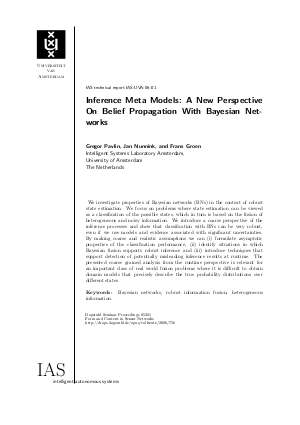Robustness and Accuracy of Bayesian Information Fusion Systems
Authors Gregor Pavlin, Jan Nunnink, Frans Groen
-
Part of:
Volume:
Dagstuhl Seminar Proceedings, Volume 5381
Part of: Series: Dagstuhl Seminar Proceedings (DagSemProc) - License:
 Creative Commons Attribution 4.0 International license
Creative Commons Attribution 4.0 International license
- Publication Date: 2006-11-02
File

PDF
DagSemProc.05381.3.pdf
- Filesize: 485 kB
- 32 pages
Document Identifiers
Subject Classification
Keywords
- Robust Information Fusion
- Bayesian Networks
- Heterogeneous Information
- Modeling Uncertainties
Metrics
- Access Statistics
-
Total Accesses (updated on a weekly basis)
0Document
0Metadata
Abstract
Modern situation assessment and controlling applications often require efficient fusion of large amounts of heterogeneous and uncertain information. In addition, fusion results are often mission critical. It turns out that Bayesian networks (BN) are suitable for a significant class of such applications, since they facilitate modeling of very heterogeneous types of uncertain information and support efficient belief propagation techniques. BNs are based on a rigorous theory which facilitates (i) analysis of the robustness of fusion systems and (ii) monitoring of the fusion quality. We assume domains where situations can be described through sets of discrete random variables. A situation corresponds to a set of hidden and observed states that the nature `sampled' from some true distribution over the combinations of possible states. Thus, in a particular situation certain states materialized while others did not, which corresponds to a point-mass distribution over the possible states. Consequently, the state estimation can be reduced to a classification of the possible combinations of relevant states. We assume that there exist mappings between hidden states of interest and optimal decisions/actions. In this context, we consider classification of the states accurate if it is equivalent to the truth in the sense that knowing the truth would not change the action based on the classification. Clearly, BNs provide a mapping between the observed symptoms and hypotheses about hidden events. Consequently, BNs have a critical impact on the fusion accuracy. We emphasize a fundamental difference between the model accuracy and fusion (i.e.classification) accuracy. A BN is a generalization over many possible situations that captures probability distributions over the possible events in the observed domain. However, even a perfect generalization does not necessarily support accurate classification in a particular situation. We address this problem with the help of the Inference Meta Model (IMM) which describes information fusion in BNs from a coarse, runtime perspective. IMM is based on a few realistic assumptions and exposes properties of BNs that are r elevant for the construction of inherently robust fusion systems. With the help of IMM we show that in BNs featuring many conditionally independent network fragments inference can be very insensitive to the modeling parameter values. This implies that fusion can be robust, which is especially relevant in many real world applications where we cannot obtain precise models due to the lack of sufficient training data or expertise. In addition, IMM introduces a reinforcement propagation algorithm that can be used as an alternative to the common approaches to inference in BNs. We can show that the classification accuracy of this propagation algorithm is asymptotically approaching 1 as the number of conditionally independent network fragments increases. Because of these properties, the propagation algorithm can be used as a basis for effective detection of misleading fusion results as well as discovery of inadequate modeling components and erroneous information sources.
Cite As Get BibTex
Gregor Pavlin, Jan Nunnink, and Frans Groen. Robustness and Accuracy of Bayesian Information Fusion Systems. In Form and Content in Sensor Networks. Dagstuhl Seminar Proceedings, Volume 5381, Schloss Dagstuhl – Leibniz-Zentrum für Informatik (2006)
https://doi.org/10.4230/DagSemProc.05381.3
BibTex
@InProceedings{pavlin_et_al:DagSemProc.05381.3,
author = {Pavlin, Gregor and Nunnink, Jan and Groen, Frans},
title = {{Robustness and Accuracy of Bayesian Information Fusion Systems}},
booktitle = {Form and Content in Sensor Networks},
series = {Dagstuhl Seminar Proceedings (DagSemProc)},
ISSN = {1862-4405},
year = {2006},
volume = {5381},
editor = {Leonidas Guibas and Uwe D. Hanebeck and Thomas C. Henderson},
publisher = {Schloss Dagstuhl -- Leibniz-Zentrum f{\"u}r Informatik},
address = {Dagstuhl, Germany},
URL = {https://drops.dagstuhl.de/entities/document/10.4230/DagSemProc.05381.3},
URN = {urn:nbn:de:0030-drops-7561},
doi = {10.4230/DagSemProc.05381.3},
annote = {Keywords: Robust Information Fusion, Bayesian Networks, Heterogeneous Information, Modeling Uncertainties}
}
